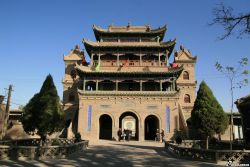Najiahu Mosque
The Najiahu Mosque, a famous Muslim mosque in northwest China, is located in Yongning County, Yinchuan. It is named after the family of Na, descendants of a Mongolian aristocrat who settled in Yinchuan during the Yuan Dynasty. During the Ming and Qing dynasties, the neighborhood of the Na family was an economic and cultural center for local Muslims.
The mosque was first built in the third year (1524) of the reign of Emperor Jiajing of the Ming Dynasty, yet was destroyed twice during the reigns of Qianlong and Tongzhi of the Qing Dynasty. The current structure was rebuilt at the end of the Qing Dynasty and rebuilt again in 1984.
The Najiahu Mosque, oriented to the east, was transformed into a courtyard built in a traditional Chinese architectural style, comprising a front gate-tower, a pair of aisle suites, a main hall and a bathhouse spread out over a rectangular area of 2 hectares, overgrown with pine and cypress trees. The main hall is large enough to seat 1,000 people at prayer. The buildings on the premises are adorned with numerous boards and couplets with calligraphic inscriptions on them, one explaining the origin of the Na family and the mosque itself: “My family left Qin (central China) and moved to Xixia, and built this temple during the reign of Emperor Jiajing.” After receiving repeated facelifts, the mosque is now opened for international cultural and religious exchanges.
The gate tower is the most striking structure. It is popularly known as “Bangke Building” or the “Minaret”. It is like a city gate, with two stone drums preserved in the middle gate. Over the gate is a three-story fly-eave structure, known as “Wang Yue Lou” (moon-viewing building). People ascend its 21-meter height to gaze on the moon during Ramadan. Flanking the courtyard are two three-story structures, the real minaret from which the Imam calls people to prayer.
The main structure is a prayer hall with an entry portico and flying eaves. Behind it is the central prayer hall, covering more than 950 sq. m., capable of accommodating more than 1,000 people. The central hall is supported by pillars, surrounded by corridor pillars, totaling 84 in number. The wings of the central hall have large and small rooms covering 240 square meters, with larger ones serving as conference and reception rooms, and smaller ones for use by the Akhund and the manlas as studies and dormitories.
In 1988, the mosque was listed as a cultural relic for priority protection of the Ningxia Hui Autonomous Region.
